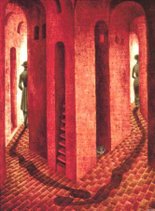Too often, communication barriers exist between those who can hear and those who cannot. Sign language has helped bridge such gaps, but many people are still not fluent in its motions and hand shapes.
Thanks to a group of University of Houston students, the hearing impaired may soon have an easier time communicating with those who do not understand sign language. During the past semester, students in UH’s engineering technology and industrial design programs teamed up to develop the concept and prototype for MyVoice, a device that reads sign language and translates its motions into audible words. Recently, MyVoice earned first place among student projects at the American Society of Engineering Education (ASEE) - Gulf Southwest Annual Conference.
The development of MyVoice was through a collaborative senior capstone project for engineering technology students (Anthony Tran, Jeffrey Seto, Omar Gonzalez and Alan Tran) and industrial design students (Rick Salinas, Sergio Aleman and Ya-Han Chen). Overseeing the student teams were Farrokh Attarzadeh, associate professor of engineering technology, and EunSook Kwon, director of UH’s industrial design program.
MyVoice’s concept focuses on a handheld tool with a built-in microphone, speaker, soundboard, video camera and monitor. It would be placed on a hard surface where it reads a user’s sign language movements. Once MyVoice processes the motions, it then translates sign language into space through an electronic voice. Likewise, it would capture a person’s voice and can translate words into sign language, which is projected on its monitor.
The industrial designers researched the application of MyVoice by reaching out to the deaf community to understand the challenges associated with others not understanding sign language. They then designed MyVoice, while the engineering technology students had the arduous task of programming the device to translate motion into sound.
“The biggest difficulty was sampling together a databases of images of the sign languages. It involved 200-300 images per sign,” Seto said. “The team was ecstatic when the prototype came together.”
From its conceptual stage, MyVoice evolved into a prototype that could translate a single phrase: “A good job, Cougars.”
“This wasn’t just a project we did for a grade,” said Aleman, who just graduated from UH. “While designing and developing it, it turned into something very personal. When we got to know members of the deaf community and really understood their challenges, it made this MyVoice very important to all of us.”
Since MyVoice’s creation and first place prize at the ASEE conference, all of the team members have graduated. Still, Aleman said that the project is not history.
“We got it to work, but we hope to work with someone to implement this as a product,” Aleman said. “We want to prove to the community that this will work for the hearing impaired.”
“We are proud of such a contribution to society through MyVoice, which breaks the barrier between deaf community and common society,” added Attarzadeh.
Based in UH’s College of Technology, the Department of Engineering Technology focuses on analyzing, applying, implementing and improving existing and emerging technologies. The program prepares graduates for the practice of engineering connected with product improvement, manufacturing and operational functions. Majors include computer engineering technology, electrical power engineering technology and mechanical engineering technology. The program offers both bachelor’s and master’s degrees. For more details on the Department of Engineering Technology, visit http://www.tech.uh.edu/departments/engineering-technology/.
UH's Industrial Design program in the Gerald D. Hines College of Architecture grooms aspiring designers through a calculated curriculum program. First-year students learn design fundamentals in the classroom and the studio. During their second year, students familiarize themselves with industrial design history, materials, manufacturing methods and visual communications skills. Third-year students conduct research and apply their findings to design projects. By their fourth year in the program, students are prepared for careers through curriculum addressing diverse design issues, design ethics, business practices and strategies. In 2013, UH will debut a graduate program in industrial design.















